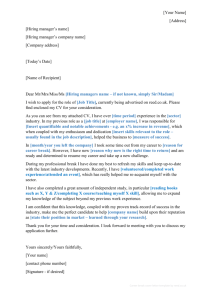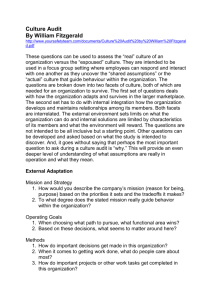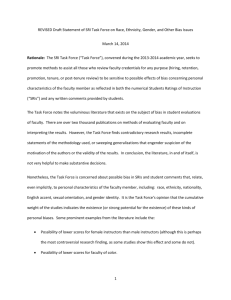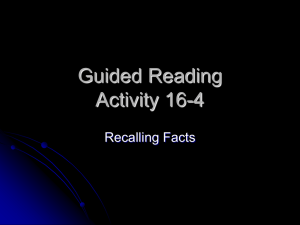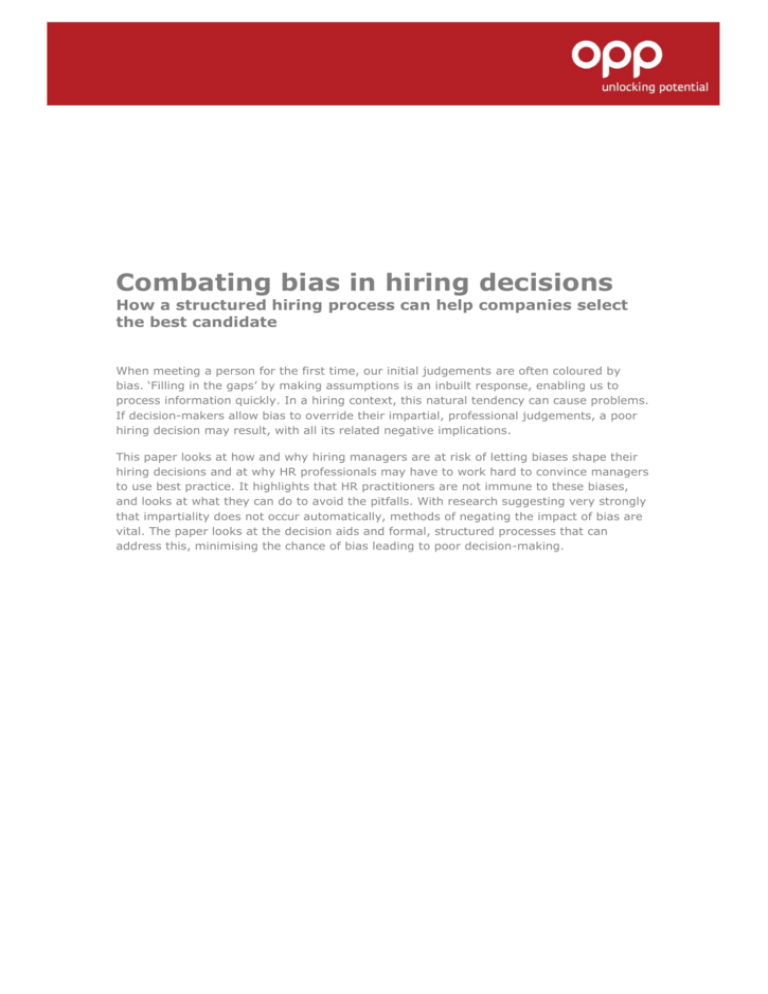
Top tips for building high-performance teams
Combating bias in hiring decisions
How a structured hiring process can help companies select
the best candidate
When meeting a person for the first time, our initial judgements are often coloured by
bias. ‘Filling in the gaps’ by making assumptions is an inbuilt response, enabling us to
process information quickly. In a hiring context, this natural tendency can cause problems.
If decision-makers allow bias to override their impartial, professional judgements, a poor
hiring decision may result, with all its related negative implications.
This paper looks at how and why hiring managers are at risk of letting biases shape their
hiring decisions and at why HR professionals may have to work hard to convince managers
to use best practice. It highlights that HR practitioners are not immune to these biases,
and looks at what they can do to avoid the pitfalls. With research suggesting very strongly
that impartiality does not occur automatically, methods of negating the impact of bias are
vital. The paper looks at the decision aids and formal, structured processes that can
address this, minimising the chance of bias leading to poor decision-making.
Combating bias in hiring decisions
© Copyright 2013 OPP Ltd. All rights reserved.
® Myers-Briggs Type Indicator, Myers-Briggs and MBTI are trade marks or registered trade marks of the MBTI Trust, Inc. in
the USA and other countries. OPP is licensed to use these trade marks in Europe.
® 16PF is a registered trade mark of the Institute for Personality and Ability Testing, Inc. (IPAT) in the United States and
other countries. IPAT is a wholly owned subsidiary of OPP Ltd.
2
Combating bias in hiring decisions
Introduction
In a recent psychology studyi, science faculties
were presented with CVs for a lab manager
job. When evaluating the applications, HR
managers consistently rated the male
candidates higher than the female ones on
competence and hirability. You might conclude
that the male applicants had more relevant
experience for the job than the female
applicants. There is, however, one important
detail we have not mentioned: apart from
gender, all the CVs were identical.
In another studyii, hiring decision-makers rated
candidates on a recorded interview. The
interviews were identical except for the
candidates’ accents and names: some were
representative of people from an ethnic
minority and some were not. In spite of the
interviews being exactly the same, the nonethnic candidates were viewed more positively
by the decision makers, which ultimately
affected the hiring decision.
When we meet a new person we need to take
in and process a large amount of information.
To avoid being overwhelmed by it all, we use
psychological mechanisms in the form of
mental shortcuts, to categorize and simplify
the impressions we get from that person. This
process includes using cues relating to the
categories that are most prominent (eg gender
or ethnicity), and using these cues to retrieve
stored information and expectations we have
about the likely behaviour of people in those
categoriesiii.
Unintentional discrimination
puts HR professionals at
serious risk of missing the
best candidates for a job and
making hiring decisions with
costly and possibly adverse
legal consequences
These are just two examples from a large body
of research pointing in the same direction: we
may think we take informed hiring decisions,
but we are biased in our impressions of others.
This is especially true for hiring decisions that
are taken intuitively, based on ‘gut feeling’.
Unintentional discrimination puts recruiting
managers at serious risk of missing the best
candidates and making hiring decisions that
have costly and possibly adverse legal
consequences. And yet a surprisingly large
number of decision makers trust their
subjective judgement rather than objective
decision aids. It is important for all of those
involved in the selection process (including HR
practitioners) to accept the fact that we are all
prone to bias, and to embrace methods of
minimising its effects in the hiring process.
So biases are aids to help us quickly make
sense of the information we are presented with
when meeting others. For instance, the process
helps us immediately to know why, and in
what ways, a person dressed in a police
uniform will behave differently from other
people in the street.
The function of bias
In the hiring process, decision-makers are
typically presented with an incomplete set of
data about the applicant, and risk ‘filling in the
gaps’ by attributing additional characteristics
based on the most prominent informationiv. By
not being aware of the influence that bias has
on us all, managers risk making costly
recruitment mistakes, including poor hiring
Bias has a negative connotation, and most of
us would like to think it does not apply to us –
especially if our profession is all about people.
The reality is that we are all biased in our
impressions and judgements, and these biases
actually serve important functions.
Bias in the hiring process
The use of biases is necessary, even
unavoidable, but it causes problems. As we
only need a few cues for a biased judgement to
take place, the most prominent preconceptions
– eg Asian people are good at maths, women
are caring – will guide our perceptions. It is
therefore possible that we will fail to capture
the richness of a person’s personality and
abilities.
3
Combating bias in hiring decisions
decisions, wasted investment in training, low
productivity and even the need to carry out
dismissal procedures. Another dangerous pitfall
is to accidently apply discriminatory
recruitment practices that violate the 2010
Equality Act.
How does bias influence the
hiring process?
A review of current research suggests that the
most common biases affecting the hiring
process are as follows:
1. In-group bias
The tendency for people to prefer people from
their own group, or denigrate those from
othersv. For example, one study suggested that
young managers favour young applicantsvi.
This effect is especially powerful for traits such
as gender, ethnicity or social class, but also
accounts for similarities in less evident
categories such as professional background
and interests.
2. Prejudice
An implicit, emotional reaction that evokes
negative psychological representations of
categories of people. People are more likely to
have strong prejudices about people from
different groups to their own, and about
minority groupsvii. An example of this was
given earlier: how decision-makers favoured
non-ethnic names and accents over ethnic
ones.
3. The Halo/Horns effect
This occurs when the rater’s judgement of a
person’s character is generalized from a
positive (halo) or negative impression (horns)
in one specific criterion. Beauty is shown to
produce a halo effect, explained by research as
the ‘what is beautiful is good’ phenomenon,
where physically attractive people are seen as
more intelligent, warmer and with greater
social skillsviii. For instance, studies have shown
that when viewing photographs on CVs,
decision-makers favour attractive applicants
over non-attractive ones.
4. Confirming bias
The tendency for people to make an initial
judgement and then look for evidence to back
it up. Research has shown that when
evaluating members of a stereotyped group,
decision-makers pay more attention to
information that is consistent with that
stereotype than to inconsistent information,
and may be entirely unaffected by information
that contradicts the stereotypeix.
5. Biased recall
The tendency to make memory errors
consistent with stereotypes and prejudices,
even when presented with objective facts to
the contrary, such as test scoresx .
Why is the hiring process
vulnerable to the influence of
bias?
It is clear that biases automatically influence
evaluations and perceptions and that this
psychological process is particularly prominent
in hiring. But why should the hiring process be
so vulnerable to bias? There are a number of
reasons.
Firstly, hiring decisions are based on limited
information as the process involves assessing
job applicants who are complete strangers.
CVs, application letters and work samples can
only provide a sketch of the applicant’s
personality and skills. As we have seen,
research suggests that bias starts to influence
the decision-maker even before the first
encounter, as biases are triggered merely from
seeing a picture or a name in the applicationxi.
Studies have shown that
when viewing photographs
on CVs, decision-makers
favour attractive applicants
over non-attractive ones
Secondly, hiring is often based on relatively
fast decisions and performed under timepressure. It is under these circumstances that
4
Combating bias in hiring decisions
biases have an especially strong influence on
our perception and impression of a person, and
consequently on decision-makingxii.
The solution: a structured
approach to hiring
Furthermore, the interview process is
particularly vulnerable to bias. Despite the fact
that it is the most frequently-used recruitment
tool, research suggests that the traditional
interview is a poor predictor of job successxiii
(See illustrative graph below). One crucial
reason is that it allows for a lot of biases.
Inconsistent and intuition-based interviewing
presents many opportunities for subjectivity
and personal preferences. As much as ‘gut
feeling’ might feel right, research shows that it
may fool us into favouring people like
ourselves (in-group bias) and charismatic
people (halo effect), or cause us to reject
someone for characteristics they do not
actually possess (prejudice).
Accepting the fact that we are all biased, how
can we arrive at correct and effective hiring
decisions? In other words, how can we make
sure that the relevant skills and personal
attributes determine who gets the job, not
gender, ethnicity or any other irrelevant
characteristic. The best way to combat the
influence of biases is to prevent them from
taking a grip and influencing us in the first
place. Psychological research is conclusive in
showing us how: a structured approach helps
companies select the best person for the job
and enables HR professionals to document and
explain his/her choice clearly.
Finally, many managers erroneously believe
that biases do not influence them as they
influence others. HR professionals have a key
role in reducing bias. However, research shows
that, despite evidence to the contrary, many
HR practitioners believe that they can hire the
best employees without any decision aids, and
that they tend to rely on their experience and
intuitionxiv. The rejection of the fact that biases
influence us all is in itself a reason why biases
continue to have a negative effect on
important hiring decisions.
Job analysis
Job analysis is a crucial component of a
structured approach to hiring. It is effective in
combating the influence of bias as it helps HR
professionals to have clear expectations of
what they are looking for in a candidate. The
process of job analysis enables identification of
the key competencies and performance criteria
important for success in the job. This
information allows decision-makers to develop
a valid person specification that can be used to
identify the key skills and characteristics of the
future job holder. The job analysis diminishes
the power of biases by helping HR
professionals spell out which human attributes
they want to measure in the CV, application
and interview, and giving them objective
criteria against which candidates can be
xvi
measured. All of this is to be done before the
recruitment starts; the selection criteria are
then adhered to despite any bias that might
tempt recruiting staff away from the criteria.
Structured interviewing
Key for the graph:
A validity index of 1 would show a perfect
fit between the measure and what it is
predicting; 0 shows no relationship; 0.4
and above is a respectable score. xv
Research suggests that adding structure to the
interview process can improve its predictive
power and reliability. When interviews are
more standardised and objective, they become
more relevant to the job analysis and the
criteria central to the job. Research indicates
that imposing structure reduces the influence
of bias. By implementing strict guidelines for
5
Combating bias in hiring decisions
the content based on job analysis and reducing
the influence of intuitive evaluations through
consistent scoring systems, interviewers are
encouraged to concentrate on the quality of
the content at the expense of irrelevant and
misleading cues that might trigger biasxvii.
Psychometrics and other decision aids
Another way of structuring the hiring process is
to include objective decision aids. One of the
outputs of the job analysis will be a listing of
traits and human attributes required by a
successful applicant. These can be objectively
and empirically measured with personality
assessments that, in contrast to subjective
evaluation, are proven to accurately predict
behaviourxviii. Part of the explanation for this
accuracy is that personality tests decrease the
impact of misleading psychological biases.
Well-constructed personality tests, unlike
people, are ‘blind’, as they consistently
measure the underlying personality traits in
the candidatesxix. An example of an OPP
personality assessment is the 16PF personality
questionnaire.
Awareness
As stated previously, denying that biases
influence us all is a chief reason why biases
continue to affect important hiring decisions.
Through forcing decision-makers to
consistently explain and document the decision
process in relation to the job analysis, a
structured approach is created, encouraging
HR professionals to be aware of the power of
biasesxx. Training is an effective way to
challenge even deeply held biases. Two main
types of training may be appropriate:
1. Diversity training, which helps people
to understand the value of diversity
and to appreciate that all people hold
some form of bias
2. Self-awareness training using
instruments such as the MBTI
questionnaire can help people to
realise the value of people different
from themselves and to understand
what assumptions they have made
about the desirability of their own type.
Summary
We are all biased in our impressions of others.
This is due to the fact that we have to simplify
the world around us to make sense of it.
However, biases can cause anyone to make
poor hiring decisions that have costly and even
illegal consequences. As decision-makers are
typically presented with an incomplete set of
data about the applicant and yet need to make
decisions quickly, they risk ‘filling in the gaps’
by attributing additional characteristics based
on the information that is most prominent to
them. As much as ‘gut-feeling’ might feel like a
sound measure of judgement, research shows
that it is biased, fooling us to favour people
like ourselves as a consequence of in-group
bias, and to reject someone for characteristics
they do not possess, as a result of prejudice,
etc.
HR managers are not immune from these
effects. As experts in people, they can rely too
much on their intuition and experience in the
interview and throughout the hiring process.
They have a particular responsibility to be
aware of these issues, given their expertise
and leadership in this area.
The research is conclusive: a structured hiring
process helps companies select the best
candidate. Job analysis, structured interviewing
and objective decision aids help decisionmakers spell out which human attributes they
want to measure in the hiring process and
encourage them to focus on competencies and
underlying traits rather than misleading cues
that might trigger bias. Both hiring managers
and the HR professionals who advise them
must accept the fact that we are all biased and
realise the business benefits of combating the
influence of bias through a structured hiring
process.
6
Combating bias in hiring decisions
References
i
Moss-Racusin, C., Dovidio, J.F., Brescoll, V.L., Graham, M.J., & Handelsman, J. (2012). Science faculty’s subtle
gender biases favor male students. Proceedings of the National Academy of Sciences of the United States of
America, 109 (41), 16474-16479. doi: 10.1073/pnas.1211286109
ii
Segrest Purkiss, S.L., Perrewé, P.L., Gillespie, T.L., Mayes, B.T. & Ferris, G.R. (2006). Implicit sources of bias in
employment interview judgments and decisions. Organizational Behavior and Human Decision Processes,
101(2006), 152-167. doi:10.1016/j.obhdp.2006.06.005
iii
MacGarty, C., Yzerbyt, V.Y. & Spears, R. (2002). Stereotypes as Explanations The formation of meaningful
beliefs about social groups. Cambridge University Press, Cambridge.
iv
Kutcher, E. & Ragger, J.E.(2004). Selection Interviews of Overweight Job Applicants: Can Structure Reduce the
Bias? Journal of Applied Social Psychology, 34(10), 1993-2022. doi: 10.111/j.1559-1816.2004.tb02688.x
v
Bendick, M. Jr & Nunes, A.P. (2012). Developing the research basis for controlling bias in hiring. Journal of
social issues, 68(2). 238-262. doi: 10.111/j.1540-4560.2012.01747.x
vi
Fikelstein, L.M., Burke, M.J., & Raju, N.S. (1995). Age discrimination in simulated employment contexts: an
integrative analysis. Journal of Applied Psychology, 80(6), 652-662. doi: 10.1037/0021- 9010.80.6.652
vii
Segrest Purkiss, S.L., Perrewé, P.L., Gillespie, T.L., Mayes, B.T. & Ferris, G.R. (2006). Implicit sources of bias in
employment interview judgments and decisions. Organizational Behavior and Human Decision Processes,
101(2006), 152-167. doi:10.1016/j.obhdp.2006.06.005
viii
Kutcher, E. & Ragger, J.E. (2004). Selection Interviews of Overweight Job Applicants: Can Structure Reduce
the Bias? Journal of Applied Social Psychology, 34(10), 1993-2022. doi: 10.111/j.1559-1816.2004.tb02688.x
ix
Bendick, M. Jr & Nunes, A.P. (2012). Developing the research basis for controlling bias in hiring. Journal of
social issues, 68(2). 238-262. doi: 10.111/j.1540-4560.2012.01747.x
x
Bendick, M. Jr & Nunes, A.P. (2012). Developing the research basis for controlling bias in hiring. Journal of
social issues, 68(2). 238-262. doi: 10.111/j.1540-4560.2012.01747.x
xi
Bendick, M. Jr & Nunes, A.P. (2012). Developing the research basis for controlling bias in hiring. Journal of
social issues, 68(2). 238-262. doi: 10.111/j.1540-4560.2012.01747.x
xii
Bendick, M. Jr & Nunes, A.P.(2012). Developing the research basis for controlling bias in hiring. Journal of
social issues, 68(2). 238-262. doi: 10.111/j.1540-4560.2012.01747.x
xiii
Kutcher, E. & Ragger, J.E. (2004). Selection Interviews of Overweight Job Applicants: Can Structure Reduce
the Bias? Journal of Applied Social Psychology, 34(10), 1993-2022. doi: 10.111/j.1559-1816.2004.tb02688.x
xiv
Lodato, M.A., Highhouse, S. & Brooks, M.E.(2011). Predicting professional preferences for intuition-based
hiring. Journal of Managerial Psychology, 26(5), 352-365. doi: 10.11081/02683941111138985
xv
Robertson, I.T. & Smith, M. (2010). Personnel selection. Journal of Occupational and Organizational
Psychology, 74 (4), 441-472. doi: 10.1348/096317901167479
xvi
Jones, J.W., Steffy, B.D. & Bray, D.W. (1991). Applying Psychology in Business: the handbook for managers
and human resource professionals. Lexinton Books, NY.
xvii
Kutcher, E. & Ragger, J.E.(2004). Selection Interviews of Overweight Job Applicants: Can Structure Reduce
the Bias? Journal of Applied Social Psychology, 34(10), 1993-2022. doi: 10.111/j.1559-1816.2004.tb02688.x
xviii
Lodato, M.A., Highhouse, S. & Brooks, M.E. (2011). Predicting professional preferences for intuition-based
hiring. Journal of Managerial Psychology, 26(5), 352-365. doi: 10.11081/02683941111138985
xix
Conn, S. R & Rieke M.L. (1994). The 16PF® fifth edition technical manual. Champaign, Illinois: Institute for
Personality and Ability Testing, Inc.
xx
Jones, J.W., Steffy, B.D. & Bray, D.W. (1991). Applying Psychology in Business: the handbook for managers
and human resource professionals. Lexinton Books, NY.
7
About OPP
OPP specialises in personality assessment, enabling people and organisations around the world
to increase their effectiveness through the innovative application of psychological tools and
techniques.
The company’s market-leading psychometric tools include the Myers-Briggs Type Indicator® and
the 16PF® assessment, which provide high-impact results for recruitment and personal
development, such as teambuilding, leadership development, communication and conflict
resolution.
With more than 20 years’ experience providing consultancy services and training programmes,
our assessment tools and resources have transformed the businesses of thousands of
organisations globally, including the majority of the FTSE 100.
www.opp.com
Oxford, UK – Chicago, USA – Paris, France – Diegem, Belgium –Amsterdam, The Netherlands


